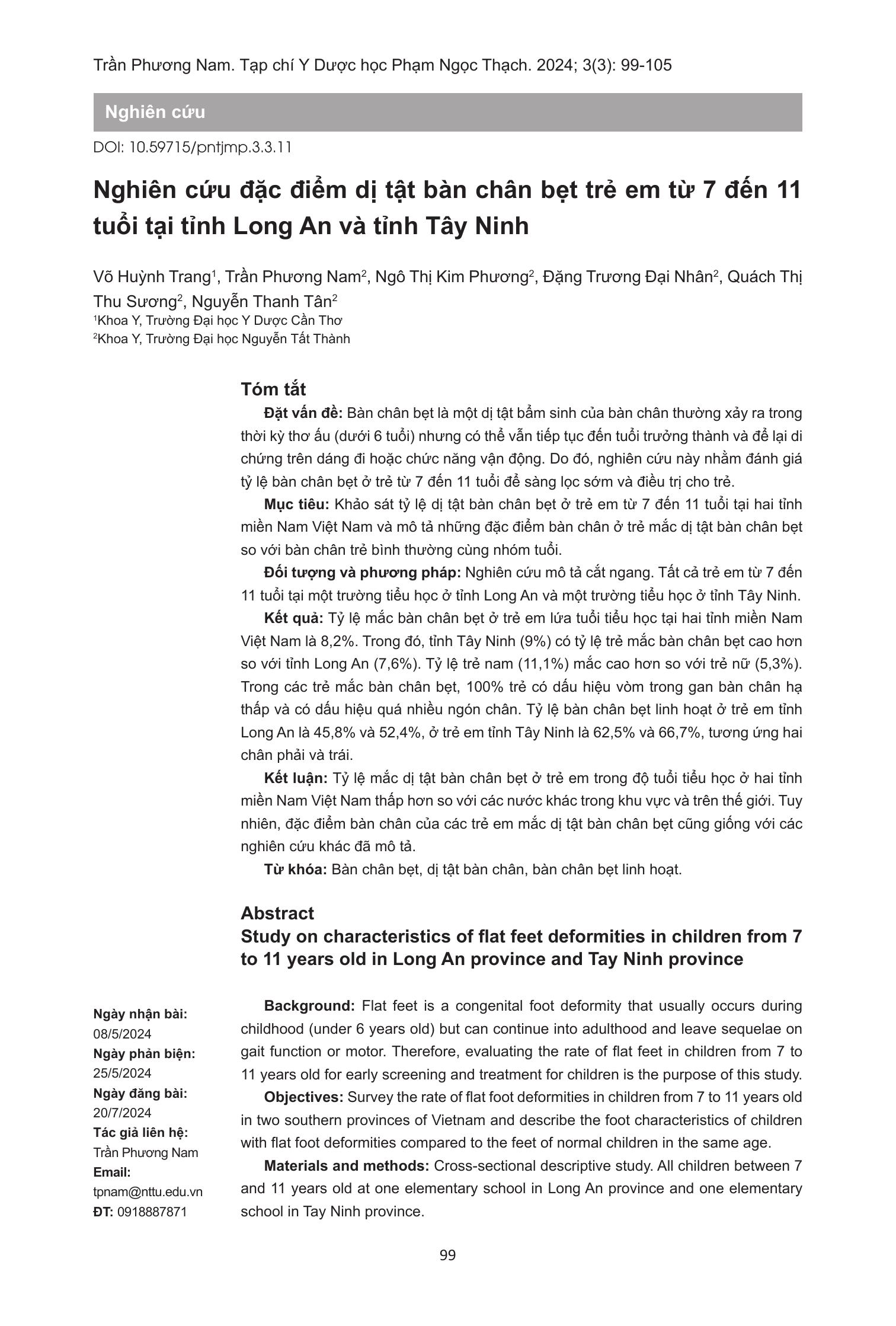Do đó, nghiên cứu này nhằm đánh giá tỷ lệ bàn chân bẹt ở trẻ từ 7 đến 11 tuổi để sàng lọc sớm và điều trị cho trẻ. Mục tiêu: Khảo sát tỷ lệ dị tật bàn chân bẹt ở trẻ em từ 7 đến 11 tuổi tại hai tỉnh miền Nam Việt Nam và mô tả những đặc điểm bàn chân ở trẻ mắc dị tật bàn chân bẹt so với bàn chân trẻ bình thường cùng nhóm tuổi. Đối tượng và phương pháp: Nghiên cứu mô tả cắt ngang. Tất cả trẻ em từ 7 đến 11 tuổi tại một trường tiểu học ở tỉnh Long An và một trường tiểu học ở tỉnh Tây Ninh. Kết quả: Tỷ lệ mắc bàn chân bẹt ở trẻ em lứa tuổi tiểu học tại hai tỉnh miền Nam Việt Nam là 8,2%. Trong đó, tỉnh Tây Ninh (9%) có tỷ lệ trẻ mắc bàn chân bẹt cao hơn so với tỉnh Long An (7,6%). Tỷ lệ trẻ nam (11,1%) mắc cao hơn so với trẻ nữ (5,3%). Trong các trẻ mắc bàn chân bẹt, 100% trẻ có dấu hiệu vòm trong gan bàn chân hạ thấp và có dấu hiệu quá nhiều ngón chân. Tỷ lệ bàn chân bẹt linh hoạt ở trẻ em tỉnh Long An là 45,8% và 52,4%, ở trẻ em tỉnh Tây Ninh là 62,5% và 66,7%, tương ứng hai chân phải và trái. Kết luận: Tỷ lệ mắc dị tật bàn chân bẹt ở trẻ em trong độ tuổi tiểu học ở hai tỉnh miền Nam Việt Nam thấp hơn so với các nước khác trong khu vực và trên thế giới. Tuy nhiên, đặc điểm bàn chân của các trẻ em mắc dị tật bàn chân bẹt cũng giống với các nghiên cứu khác đã mô tả. Abstract Background: Flat feet is a congenital foot deformity that usually occurs during childhood (under 6 years old) but can continue into adulthood and leave sequelae on gait function or motor. Therefore, evaluating the rate of flat feet in children from 7 to 11 years old for early screening and treatment for children is the purpose of this study. Objectives: Survey the rate of flat foot deformities in children from 7 to 11 years old in two southern provinces of Vietnam and describe the foot characteristics of children with flat foot deformities compared to the feet of normal children in the same age. Materials and methods: Cross-sectional descriptive study. All children between 7 and 11 years old at one elementary school in Long An province and one elementary school in Tay Ninh province. Results: The prevalence of flat feet in primary school-age children in two Southern provinces of Vietnam is 8.2%. Of which, Tay Ninh province (9%) has a higher rate of children with flat feet than Long An province (7.6%). The proportion of male children (11.1%) infected is higher than that of female children (5.3%). Among children with flat feet, 100% of children have signs of lowered arches in the soles of their feet and signs of too many toes. The rate of flexible flat feet in children in Long An province is 45.8% and 52.4%, in children in the Tây Ninh is 62.5% and 66.7%, the right and left feet respectively. Conclusion: The incidence of flat foot deformities in children of primary school age in two Southern provinces of Vietnam is lower than in other countries in the region and the world. However, the foot characteristics of children with flatfoot deformities are similar to what other studies have described. DOI: 10.59715/pntjmp.3.3.11










Thêm một bài đánh giá
Xếp hạng
Không có bài đánh giá nào!